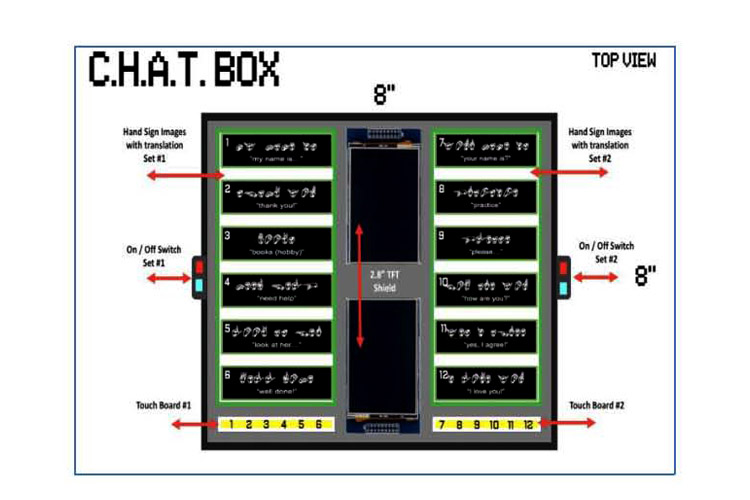Two-way Schemed Communication Device for Speech and Hearing Impairment
Patent Number: PH-1-2019-000449
Patent Title: Two-way Schemed Communication Device For Speech and Hearing Impairment
Description
A box-shaped two-way communication device that bridges the language gap of deaf, mute, deaf-mute, and sign language capable individuals to those of normal or non-sign language people.
Innovative Features and Benefits:
This device consists of two major parts: (1) a surface consisting of two Bare Conductive Touch Boards preloaded with the twelve (12) phrases and words with its corresponding display of hand sign images converted to its English translation; and (2) two [2] thin film transistor (TFT) Touch Shields mounted in Arduino Mega 2560 Rev3, individually preloaded with the standard English alphabet and American Sign Language symbols.
People with speech and hearing disabilities have two (2) options in using this device. The first option is to tap the desired electrode pads on the Touch Board and the second option is to communicate using the TFT Touch Shield like a multi-touch texting option. On the other hand, the normal user communicates only via TFT Touch Shield.
This device is composed of the following processes and components:
1. Micro-controllers and Touch Boards – it has two (2) micro-controllers and two (2) touch boards which are configured to act as a powerful processing unit with built-in Li-Po and Li-Ion battery charger;
2. Standard Audio Jack and Electrode Solder Pads – it has a standard audio jack for speakers and earphones and twelve (12) electrode solder pads which produce audio when touched or tapped;
3. Innovative User Interface – it has two (2) micro-controllers with two (2) mounted screen display modules and touch board solder pads;
4. Stable UART Communication – it utilizes an RX-TX serial connection to send and receive data from one touch screen to another;
5. Top Guide – it has a surface consisting of twelve (12) hand sign images with their corresponding translations;
6. Text-to-Speech Capable – it has a third-party text-to-speech program (TTS) called Balabolka which enables the converted audio with MP3 file format to be exported within the Touch Board’s SD card memory;
7. Lightweight and Sturdy Casing – it has a lightweight packaging made from stainless alloy to form a rigid box for indoor and outdoor usage;
8. Accessories Integrated – it has two (2) earphones attached on the two touch boards separately for audio feature, and one (1) twin barrel battery charger for built-in rechargeable batteries;
9. Long-lasting Battery Consumption – it has two (2) rechargeable 9V 220mAh batteries for the microcontrollers and two (2) rechargeable 3.7V 2000mAh li-ion battery for the touch boards; and
10 .Convenient On & Off Switches – it has two (2) separate rocker switches (on/off) for the touch screens and two (2) separate built-in switches (on/off) found in the touch boards for interface purposes.
Applications:
This device targets to help and improve the current way a person with speech and hearing disabilities to communicate. Said device serves a flexible indoor and outdoor intercommunication system which gives the impaired subjects two options either to tap the desired electrode pads on the touch board or to communicate using the touch shields like texting. On the other hand, the normal user communicates only via touch screen modules.
It aims to be an everyday companion of every deaf-mute wherever they go. Imagine a community wherein, deaf-mute can order in a restaurant like a normal abled person, choosing his meals with the aid of the device, acquiring public transportation with ease of communication with the driver, a deaf-mute resource speaker sharing speeches to both normal and abled people as well as to speech and hearing impaired community. And lastly, being comfortable and confident of what they are, making the most out of their potentials and ignoring their limitations.
Business Potential
This version of the device is a prototype for deaf, mute, and deaf-mute individuals who communicates and well-versed of sign language communication. However, for future improvements, it is highly recommended to customize it for other cases of speech and hearing impairment, like difficulties in producing sounds, articulation disorders, stuttering, mumbling, buzzing, etc.
With respect to the packaging of the device, it can be upgraded using other raw materials to make its body casing sturdier and more durable. The design of the entire device can be improved for aesthetic appeal and marketability. Images displayed on the touch shields and on the surface can be altered to best fit the requirement and preference of its user.
Agencies, organizations, and institutions that teach sign language as a form of communication system are viable markets for this device.
Interested in this IP?

